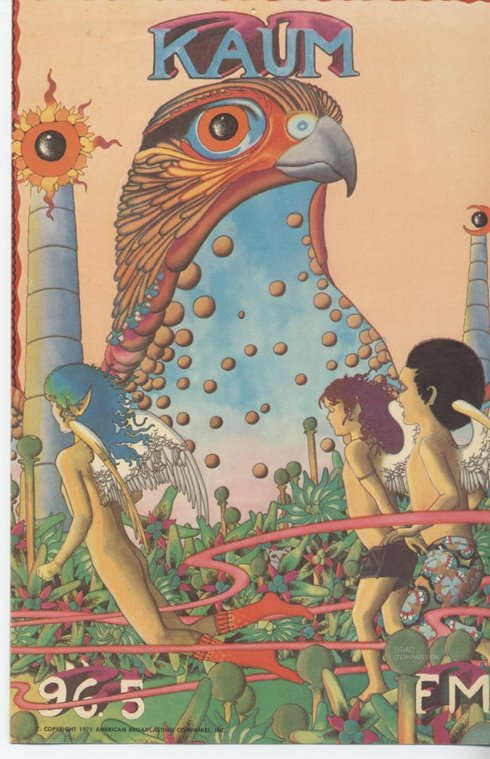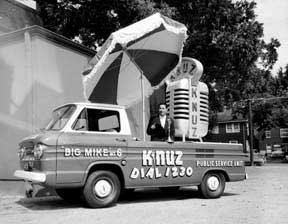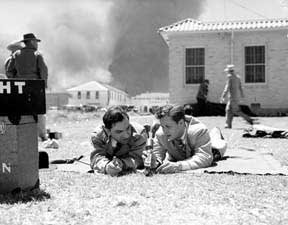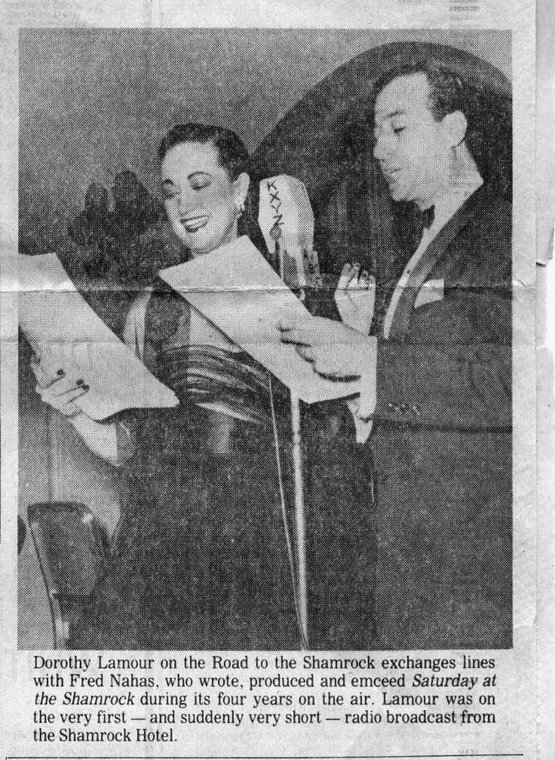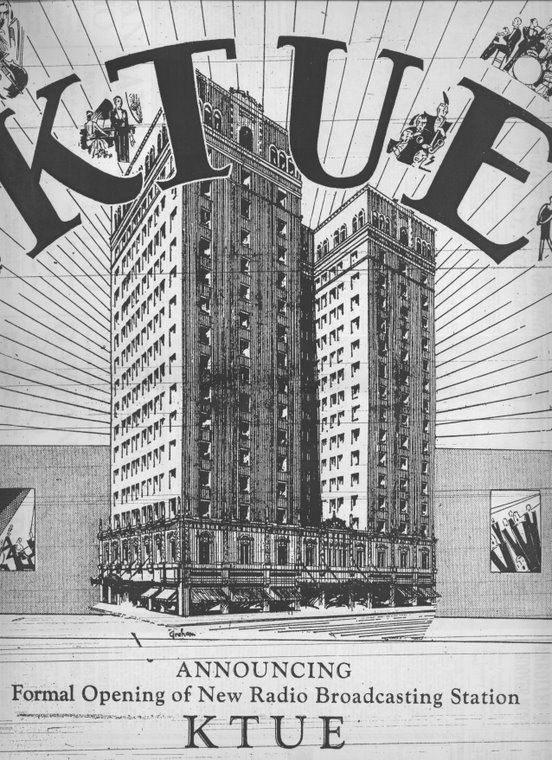Before proceeding any further with the chronology of AM stations it is necessary to to take a step back and a little side trip south of the border, down Mexico way, and introduce readers of this blog to one of the most interesting Houston broadcasters I have encountered in the course of this research. There have been two Houstonians I have learned about in this research who, in my judgement, had they stayed involved in radio all their lives, would have been as famous and garnered as much acclaim as Gordon McLendon or other luminaries in the history of broadcasting, both in this state and nationwide. Both were compared to P.T. Barnum by associates, both were born showmen and promoters, essential qualities of a good broadcaster in the old days, anyway. Some have seen them as controversial but I see their personality types as exactly what is needed to make radio more than just another ho-hum utility that comes into the house and I wish I had had the chance to work for both of them. Both had many interests besides broadcasting and by the times of their deaths their early involvement in broadcasting had been all but forgotten. The two individuals are Judge Roy Hofheinz and Will Horwitz, and this is the story of Will Horwitz - entertainment impresario, theater owner, radio station owner, philanthropist, and florist. And, oh yes, convicted and then pardoned felon.
He was the owner of Houston’s third broadcasting station, WEAY. There is much that can be written about WEAY, only a small part of which has been published on this blog so far. To read what there is click on the Label WEAY at the bottom of this post or go to the AM Chronology for 1922, Part 3. Horwitz was not strictly a radio man and much of what follows has little to do with Houston broadcasting but he is a fascinating part of the overall story of Houston broadcasting that has been lost over time. Fascinated by the power and lure of the medium even before the age of broadcasting, Horwitz was an entertainment impresario and noted philanthropist and one of the most beloved Houstonians of the first half of the 20th century who has been almost completely forgotten in the ensuing decades. He is known outside of Houston mostly for his ill-fated involvement with XED in Reynosa, Mexico, the first ‘border blaster.’
Born on the 26th of June, 1886, in Benton, Arkansas, he graduated from the University of Michigan with a Master of Arts degree and came to Houston as early as 1917. One of his jobs was showing movies at Camp Logan and it was to set his course in life.
With a borrowed stake of $150 he bought his first theatre in 1919, the Travis, a rundown burlesque theatre at 612 Travis where the JP Morgan Chase Tower now stands. As the story goes, lacking the funds to buy a new sign, he improvised. He blocked out the ‘a’ and the ‘v,’ knocked the top off of the ‘t,’ and so was born the Iris. It happened to be his daughter’s name.
He established prices of 5 and 15 cents for his theatres, angering movie producers who threatened to withhold their films from him if he didn’t raise prices, but Horwitz refused and the movie producers backed down. During the dispute he kept live hogs in the lobbies of his theatres, labeling them the ‘movie hog trust’ and would rail against the producers from the stage before shows. His group of theaters was called the Homefolks Theaters and by the time of his death he owned 4, the Uptown, Texan, Iris and Ritz, but also had owned the Isis and Liberty. He employed 240 people with an annual payroll of $200,000.
His Texan theatre was the first air conditioned theatre in Texas. While excavating to install the air conditioning in the 30s, he had the idea of connecting his theatres with an underground tunnel, so his patrons could go back and forth between them. That was one of the beginnings of the downtown Houston tunnel system.
One of his most popular promotions was a big Christmas party for needy children, an annual tradition, which may have started as early as 1919 or maybe in the mid-20s (accounts differ). He also sent movie equipment to institutions where there were youngsters who could not travel to go to the movies.
Another popular promotion was Peanut Day, held on his birthday each year, when any child would receive free admission, a free bag of peanuts and reimbursement for transportation to and from any of the theatres. This photo from the Bob Bailey Studios collection at the Center for American History at the University of Texas at Austin shows the crowd outside the Iris on Travis for Peanut Day in 1934.
During the Great Depression he established a restaurant across from the Farmer’s Market on Preston in downtown Houston called the Grub Stake which served free meals to the unemployed. A big sign proclaimed ‘If you are hungry, come in and enjoy a meal.’ The Houston Chronicle noted in an editorial that the restaurant had served 111,000 free meals in one year. He also set up a no-fee employment agency which found work for 5000 people and when the construction work on the Texan was underway, decreed that all the work was to be done by hand, no machines were to be used, so more people would have work.
Another promotion was Tin Can day at his theatres, weekly events every Tuesday during the Depression when anyone could gain admission by bringing in a can of food. Food was piled high in the lobbies on those days and he set up a store at Capitol and Travis to give it away. This blogger’s Mother and her oldest brother recalled walking downtown once a week from their home on 16th street in the Heights, following the street car tracks, to pick up free groceries for their family. When they got back home they would set aside 4 cans of food for the oldest children so the following Tuesday they could all walk back downtown to see a free movie at the Iris.
Tin Can Tuesdays were so successful, Horwitz started accepting clean, usable garments, too, and had to set up another store to distribute what was collected. He also set up a club for servicemen in the Uptown building at Capitol and Milam and paid for the care of numerous elderly people at the St. Anthony’s Home on Almeda.
He ran on-screen announcements in his theatres warning ‘goo-goo’ mashers they would be dragged out into the street and whipped, then arrested, and was known to handle that personally on occasion. He also passed out free hat pins at the ticket office for any women who wanted to protect themselves from mashers. Theater employees would watch for men who moved around frequently in the auditoriums, closing in on solo women. An employee would shadow the potential masher – sometimes Horwitz would personally take over at this point – until the man made his move. Then he would be forcibly removed from the theater. Sometimes this resulted in front page news.
He was known as a friend of labor - during a railroad strike he gave free admission to union members who showed their cards - but once he got into a row with his own union employees. The union representing his projection operators had gone on strike. Horwitz had negotiated a new deal when the musician’s union announced they were going out. Outraged they had waited to the last minute, Horwitz went to the farmer’s market and began asking if any of the vendors had any rotten eggs. All demurred except one who motioned him aside and confessed he had a case that had gone bad. Horwitz bought them all, took them back to the theatre and threw them at the musicians in the street from the marquee. Then he paid for laundry services for the innocent bystanders whose clothing had been soiled. When the disputes were worked out, the projectionists union gave him a life-time, gold-plated membership in the union, the musicians union gave him a gold egg.
In 1931, years after WEAY had folded, he bought a controlling interest in XED, a Mexican radio station in Reynosa operating with 10,000 watts, the first ‘border blaster’ station, and it got him into a lot of trouble. A promotion the station was running drew tons of mail and the interest of the US Government. The station was running ads for the Tamaulipas State Lottery and money poured into the the US offices of the station and was carried across the border to be placed. Horwitz thought the scheme was legal since the lottery was sanctioned by the Mexican government, but he, his wife and 2 employees were arrested and charged with using the US Mail to promote an illegal lottery. One of those arrested was Milton G. Hall, former Radio Editor of the Post-Dispatch and first Program Director of KTRH.
A trial was held promptly at Corpus Christi and all the defendants were found guilty, with Horwitz and the 2 men receiving 18 month sentences and Horwitz a $5000 fine. His wife was given 6 months probation.
Horwitz filed a motion for a new trial and his lawyer presented petitions bearing 20,000 names pleading for leniency. The judge refused the motion for a new trial but reduced the sentences to a year and a day and Horwitz served 6 months at Leavenworth before being released on parole. A large crowd had turned out at Union Station to see him off and he returned to Houston to another huge party at the City Auditorium attended by several thousand supporters. Reverend William States Jacobs of the First Presbyterian Church told Horwitz from the stage “If all the mud-slingers in the world were given the ocean for a bucket and a comet for a brush, they could never blacken you in my eyes.” FDR signed a full pardon for Horwitz in 1940.
Reverend Jacobs was to establish a tabernacle in the Heights and have his own problems with the government in the late 30s over the question of an unauthorized radio station operated from his ranch at Webster.
There are 2 pictures of a QSL card for XED from early 1931 on this site (4th and 5th items) and there are many other interesting pictures on the site, which is also listed among the external galleries. These cards may be from before Horwitz's involvement with the station.
Though he never owned a radio station again he remained involved in the medium, sponsoring a talent show regularly on radio, once setting up a special phone bank of 40 phones to handle callers when the program tried to determine the best Black entertainer in Houston. In the mid-30s, he installed an electronic organ in his Uptown Avenue, an amusement arcade attached to his Texan Theater, and dubbed it the Radio Mystery Organ because the sounds were created by radio tubes.
On his 46 acre estate at Dickinson Horwitz indulged his love of flowers, creating a horticultural paradise with huge greenhouses everywhere. He told a Houston Press reporter when he realized he’d put $250,000 into his hobby he decided he had to find a way to make money out of it so he opened a flower shop in downtown Houston; then he took over the floral department of Houston’s first Sears store at Buffalo Drive and Lincoln (the recently demolished Robinson Warehouse at Allen Parkway and Montrose). Asked by the reporter which of his businesses he loved the most, theatres or flowers, Horwitz said he loved them both equally but he made more money from the flower business.
For his annual Children’s Christmas Party in 1941 in conjunction with the Houston Post (the paper called it the 22nd annual), the paper reported on page 1 there were 20,000 brightly painted toys and games to be distributed, 100,000 pieces of candy and six truckloads of oranges. A 22 foot tall lighted Christmas tree stood on the stage of the City Auditorium. After the gifts were given out, there was Christmas entertainment. The first party at 4pm on Christmas Eve was for children who had written Mr. Horwitz asking for an invitation and received a written invitation in return. A second party at 7 was for any child who hadn’t been able to write for an invitation. Only 12,000 children were expected, down from 15,000 the previous year, apparently the onset of the war effort had already been putting more people back to work.
Will Horwitz usually donned the Santa suit for his big party, but in the 1930s he had developed heart problems. He had an experimental thyroid operation that was supposed to cure the problem and ever the showman he had the operation filmed so he could demonstrate to others the operation that saved his life, but the operation had done no good, and on December 23, 1941, Horwitz suffered a heart attack. On Christmas eve he lay in a bed at St. Joseph’s Infirmary, telling his associates ‘Make sure the children are happy.’ The Chronicle reported that children cried when told Mr. Horwitz would not be at the party that year, but the parties went off as planned.
Then at 2 am on Christmas Day, 1941, Horwitz suffered a second heart attack and he was pronounced dead at 5 am.
All three dailies ran front page obituaries with the Chronicle and the Press getting their’s into their afternoon editions on Christmas Day.
An associate who had been with him since the beginning in the theater business said he ranked with P.T. Barnum as an entertainer; movie people loved him and theatre owners across the country copied his promotions. The Press obituary called him one of the nation's outstanding showmen. So well known was his name to Houston theatre goers that for several years after his death, well into the 1940s, the ads for his theatres carried the legend ‘A Will Horwitz Estate Theatre.’
Horwitz was survived by his wife and one daughter. It's been suggested a whole book could easily be written about Horwitz and perhaps someone will.
Historical asides: There are many pictures of Will Horwitz and his theaters and the Children's Christmas party in the collection of Bob Bailey Photograpy Studio at the Center for American History at the University of Texas, listed in the external galleries, including one showing Horwitz outside either the Texan or Iris Theater with some children with clothing for the clothing drive but I cannot find that particular one to post. Here is a photo of Horwitz (on the left, note the name is mispelled, as it is on several of the photos) from the collection.
The original Houston Sear’s store opened in 1929 at Buffalo Drive and Lincoln Street and was flooded up to the second floor in a massive flood of Buffalo Bayou in 1935 and Sear’s abandoned it a few years later to move out on Main Street at Richmond. The Sear’s building later served as the first home of the Baylor College of Medicine in Houston and Baylor has in the past maintained a website with some pictures of the store in its heyday but this gallery is apparently no longer on line. Buffalo Drive was later renamed Allen Parkway and Lincoln Street, which ran north from Westheimer, was taken over by the northward extension of Montrose Boulevard; there is only a short remnant of Lincoln Street behind the Valero station at Westheimer and Montrose.
There are also a few pictures of the flood of 1935 in the Bob Bailey collection at the University of Texas.
For the last few decades of its life, the original Sear’s store was known as the Robinson Warehouse and it was demolished only recently to make way for an Islamic Cultural Center.








